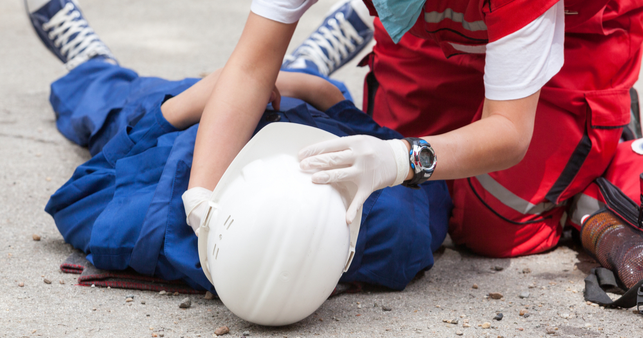
Accidents and Injuries in the Workplace
Workplace health and safety accidents can have a negative impact on a business in many ways. They can result in a loss of productivity, reduced staff morale, increased absenteeism, and even temporary or permanent closure.
According to research from Safe Work Australia, 120,355 people lodged a serious claim in 2019-20.
At Employsure, we believe that it is important that staff and employers work together to take reasonable steps to improve workplace health and safety, reduce work-related injuries, and to maintain a consistent record of each work-related injury as they occur in the form of incident reports as part of the workplace accident records.
Safe Work Australia has drafted a Model Workplace Health and Safety Act, which most States and Territories have adopted albeit with modifications. The model legislation came into force in WA in 2022, while Victoria still has its own Workplace Health and Safety laws.
It is important to check with your Workplace Health and Safety authority for State or Territory specific provisions.

Don’t Wait for Accidents to Happen. Assess the Risk Now
Learn how to identify hazards and assess risks at your workplace.
Reporting an Accident at Work
You may not be able to prevent accidents from happening at work but, if they do happen, you must handle them in a manner that satisfies your obligations. . If it is a serious incident, as well as calling the emergency services, you should notify the health and safety authority in your State or Territory immediately, in accordance with the relevant Workplace Health and Safety Legislation. Please note the information below is mainly based on the model Workplace Health and Safety legislation, and that in NSW. As such, you should consider seeking professional advice that is specific to your circumstances.
Generally, you are obligated to complete an incident report form for every incident however minor, and keep a record of every workplace accident (called a ‘Register of Injuries’ in NSW). At a minimum, this must be available at all times, and each report should contain the following information:
Name of injured worker/s
Worker’s occupation or job title at the time of the injury
Worker’s age at the time of the injury
Time and date of injury
The nature of the industry in which the injury was sustained
Exact location of the worker at the time of injury
Exact description of how the injury was sustained (cause)
If any treatment was provided to the injured, and if so, what kind of treatment
Nature of injury and the body part/s affected
Names of people who witnessed the incident take place
Date of entry in the register
Name of person making the entry
Anyone injured at work, including direct worker, agency employee, contractor, customer or visitor, must complete an incident report or be noted on the register of injuries. Always store personal data carefully in line with privacy, and health and safety legislation.
You must also review the incident to find out whether there are steps you could take to stop it from happening again. A serious injury, or risk to plant and equipment, will need a more in-depth health and safety investigation.
What Constitutes a Work Health and Safety Incident or Accident?
A notifiable workplace incident is any event that exposes a worker or any other person to a serious risk to that person’s health or safety, and it requires the relevant health and safety regulator to be notified. It may also include a ‘near miss’ where no actual injury occurs. Under the various Work Health and Safety (WHS) Acts (2011/2012), other than Victoria, a notifiable incident means:
The death of a person
A serious injury or illness of a person or
A dangerous incident,
arising out of a conduct of a business or undertaking at a workplace.
For example, according to the Work Health and Safety Act 2011 (NSW) a serious injury or illness of a person that requires the Workplace Health and Safety Authority, SafeWork NSW, to be notified immediately is an illness or injury that requires:
Immediate medical treatment in a hospital
Immediate treatment for:
The amputation of a persons’ body part
Serious head injury
Serious eye injury
Major burn
Separation of skin from underlying tissue
Spinal injury
Loss of certain bodily functions
Serious lacerations
Any infections transmitted to a person as a result of them carrying out work-related activities
Medical treatment within 48 hours of exposure to a substance
In Victoria under the Occupational Health and Safety Act 2004 a notifiable incident is an incident that results in:
The death of a person
A person requiring medical treatment within 48 hours of exposure to a substance
A person requiring immediate treatment as an in-patient in a hospital or
A person requiring immediate medical treatment for specified injuries (detailed in the excel spreadsheet).
A notifiable incident in Victoria is also an incident that exposes a person to specific risks, but unlike all other jurisdictions, the requirements to notify diseases is very limited. Please call us for free initial advice on work health and safety legislation in your State or Territory.
Get Workplace Advice Now
Call Our Team of Advisers To Get Help With Any Workplace Related Questions.
Investigating a Workplace Incident
Not all workplace incidents are serious enough to warrant an investigation. Once an incident report has been sent to the relevant work health and safety regulator, they will assess the following factors to determine if they should carry out an incident investigation:
Severity, or potential severity of the incident
Number of people involved in the incident
Level of risk
Complexity of the situation and amount of factors involved
If the incident is serious enough, once you have notified the Workplace Health and Safety Authority you must make sure the incident site is not disturbed, unless you need to remove the injured person or make the site safe.
This is because the local supervisor or manager – in cooperation with an expert from the relevant work health and safety regulator – must carry out a formal incident investigation procedure to:
Determine all contributing factors to the incident – whether it was an accident, near-miss, or a hazard.
Record all relevant details about the incident to support an insurance claim, workers’ compensation claim, or common law proceeding.
Comply with the applicable legislative requirements
Implement changes to eliminate or reduce the risk of the same incident happening again.
You should notify your workers compensation insurer once you have notified the emergency services (if applicable), the workplace health and safety authority, and the site has been secured.
During the investigation you must, at a minimum, collect relevant information from anyone who was involved in the incident. While you may receive some of this information in the incident report form, you will need to conduct face-to-face interviews so you can piece together the sequence of events that led to the incident.
After you collect this information, you must uncover the cause of the incident and come up with reasonable recommendations to address the contributing factors of the incident to eliminate or reduce the risk of further injury. If the injured worker has filed a workers compensation claim, you will also be required to support the injured worker in their recovery and return to work.
Identifying Workplace Hazards
In order to figure out the cause of an incident, and to make appropriate changes to eliminate or reduce the chance of the same incident happening again, you need to perform a risk assessment at the incident site.
While the nature of a workplace risk can vary from place-to-place, the most common types of hazards at work include:
Physical hazards: Slips, trips and falls, vibration and noise.
Ergonomic hazards: Certain body movements that result in harm to the musculoskeletal system. This may include repetitive movement, manual handling and poor posture.
Biological hazards: Exposure to dangerous and infectious organic substances like bacteria and viruses.
Chemical hazards: Exposure to hazardous substances found in the workplace. Common types of hazardous chemicals include neurotoxins, immune agents, asthmagens, and carcinogens.
By assessing the risk site, and using the information you collected from all parties involved, you will be able to identify the hazards and evaluate the risks, and then implement the right control measures to minimise the risk of serious injury and illness.
Employsure can help you to better understand for workplace health and safety obligations. For peace of mind, please contact 1300 651 415 for free initial advice.
BrightHR helping you manage your people and business
Contact us to find out how BrightHR people management software can help you manage and store your essential employee records and documents.
Frequently Asked Questions
How would you record details of an accident at work?
You would record details of a workplace incident by describing the incident, and completing an incident report form including any details required by the work health and safety legislation in your State and Territory. Details may include:
- Who was involved?
- What happened and how?
- When and where did the incident occur?
- How serious is the incident and what was the outcome of the incident?
You should have a template incident report form and health and safety register at your business.
How long do you have make an incident report?
Not all workplace accidents need to be reported to the health and safety authority. Only incidents that pose a serious risk to health and safety are notifiable and should be reported to the health and safety regulator. Notifiable incidents are incidents that cause:
- The death of a person at your workplace (employee, contractor, visitor or otherwise)
- A serious illness or injury
- A dangerous incident that exposed someone to a serious risk, even if there was no injury
What incidents must be reported at the workplace?
An incident report form should be completed for all incidents in the workplace and a register or record should be kept.
Notifiable incidents should be reported to the health and safety authority immediately after becoming aware of them. Notifiable incidents are incidents that cause:
- The death of a person at your workplace (employee, contractor, visitor or otherwise)
- A serious illness or injury
- A dangerous incident that exposed someone to a serious risk, even if there was no injury
What is the number 1 cause of workplace accidents?
According to Safe Work Australia’s 2018-2019 annual report, body stressing was the number one cause of workplace accidents. Body stressing is a broad term referring to health problems associated with repetitive and strenuous physical work, from lifting and carrying objects to repetitive movement like typing.
How long do WHS records have to be kept?
Workplace health and safety (WHS) records of notifiable incidents must be kept for a minimum of five years from the notification date.
Why do employers keep records of serious accidents or incident reports?
Employers must keep serious workplace accident records or incident reports due to obligations under health and safety legislation.
What are the requirements for reporting a workplace incident?
If the incident is serious, then it must be reported at a minimum to the relevant workplace health and safety authorities immediately after becoming aware of the notifiable incident. If requested to by the regulator, the employer may have to provide further reporting material within 48 hours. In Victoria the incident itself must be reported within 48 hours. If the incident is not serious, there is no obligation for an employer to report the incident to the regulator, but they should still complete an incident report form for their own records.
Who is responsible for reporting accidents in the workplace?
Any person conducting a business or undertaking (PCBU), or the employer, or person responsible for employee, worker and volunteer safety at the workplace in which the accident took place, is responsible for notifying the workplace health and safety regulator as soon as they are aware that the incident took place.
Where do most workplace accidents occur?
According to Safe Work Australia’s 2018-2019 annual report, the most workplace accidents occur in the agriculture, forestry and fishing industries, followed closely by the manufacturing, construction, and transport, post and warehousing industries.
The information in the above article has been compiled on the basis of general information current at the time of publication. Please note that the contents of this article and website and any information provided by our Fair Work Help Line do not constitute legal advice and are not intended to be a substitute for legal or other professional advice and should not be relied upon as such. Your specific circumstances or changes in circumstances after publication may affect the completeness or accuracy of this information. You should seek legal advice or other professional advice in relation to any particular matters you or your organisation may have. To the maximum extent permitted by law, we disclaim all liability for any errors or omissions contained in this information or any failure to update or correct this information. It is your responsibility to assess and verify the accuracy, completeness, currency and reliability of the information on this website, and to seek professional advice where necessary. Nothing contained on this website is to be interpreted as a recommendation to use any product, process or formulation or any information on this website. For clarity, Employsure does not recommend any material, products or services of any third parties.









